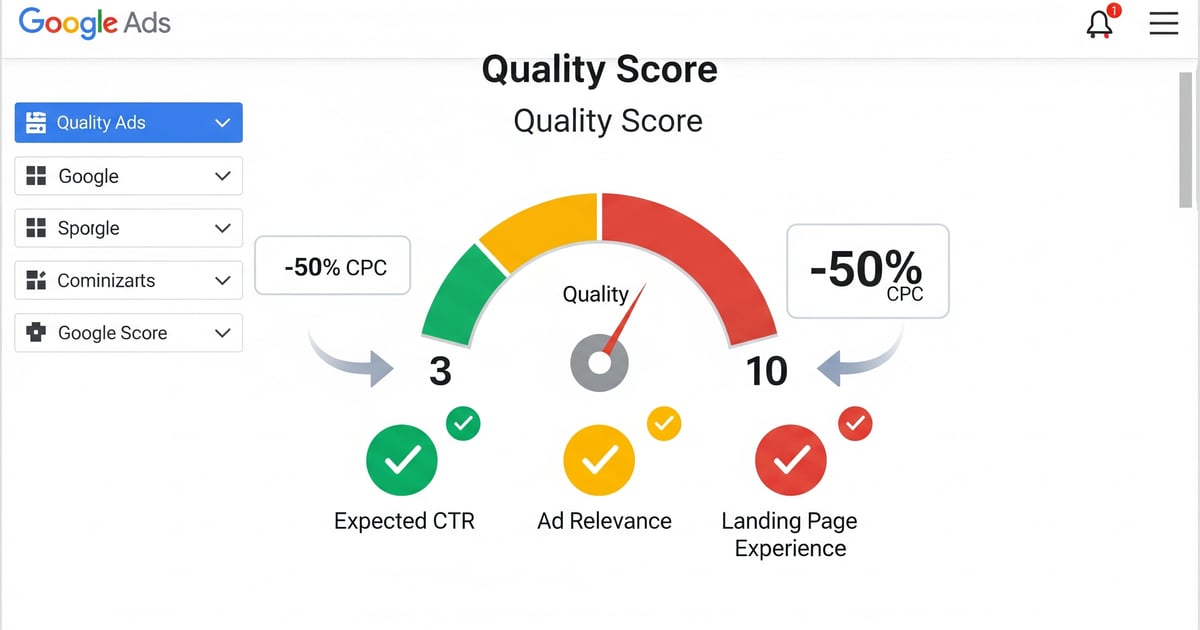Google Ads Quality Score: The Complete 2025 Optimization Guide

Google Ads Quality Score is the invisible force that can make or break your PPC campaigns. While most advertisers focus on bidding strategies and keyword research, the smartest ones know that Quality Score optimization can reduce cost-per-click by 50% or more while dramatically improving ad positions.
But Quality Score remains one of the most misunderstood metrics in digital advertising. Google’s algorithm considers dozens of factors, many of which aren’t obvious, and small improvements can compound into massive competitive advantages.
Table of Contents
Open Table of Contents
- Understanding Google Ads Quality Score in 2025
- The Quality Score Optimization Framework
- Advanced Quality Score Strategies
- Quality Score Monitoring and Maintenance
- Quality Score Recovery Case Studies
- Quality Score Myths Debunked
- Tools for Quality Score Optimization
- Future-Proofing Your Quality Score Strategy
- Your 30-Day Quality Score Improvement Plan
- Conclusion: Quality Score as Competitive Advantage
Understanding Google Ads Quality Score in 2025
What Quality Score Really Measures
Quality Score is Google’s 1-10 rating of your ad’s relevance and usefulness to searchers. But it’s not just one score—Google calculates it based on three core components:
- Expected Click-Through Rate (39% weight): How likely users are to click your ad
- Ad Relevance (28% weight): How closely your ad matches search intent
- Landing Page Experience (33% weight): How relevant and useful your landing page is
The Hidden Impact of Quality Score
Beyond the obvious CPC reduction, high Quality Score affects:
- Ad rank calculation: Higher QS = better positions with lower bids
- Auction eligibility: Low QS can prevent your ads from showing entirely
- Ad extension eligibility: Some extensions require minimum Quality Scores
- Impression share: Better QS = more opportunities to show ads
The Quality Score Optimization Framework
Phase 1: Quality Score Audit (Week 1)
Start by understanding your current Quality Score landscape:
Step 1: Export Quality Score Data
Google Ads → Keywords → Columns → Modify Columns → Quality Score
Add: Qual. score, Landing page exp., Ad relevance, Exp. CTRStep 2: Categorize Performance
- QS 8-10: Maintain and protect these keywords
- QS 5-7: Primary optimization targets
- QS 1-4: Immediate intervention required
Step 3: Identify Patterns Look for common themes among low-QS keywords:
- Broad match keywords with poor relevance
- Generic ad copy not matching search intent
- Landing pages targeting multiple keyword themes
Phase 2: Expected Click-Through Rate Optimization
The Problem: Google predicts your CTR based on historical performance. Low CTR creates a negative feedback loop—poor CTR → lower QS → worse ad positions → even lower CTR.
Solution Strategy:
1. Ad Copy Optimization
Transform weak ad copy into click magnets:
Before (CTR: 1.2%):
Project Management Software
Manage your projects efficiently
Try our software todayAfter (CTR: 4.8%):
Project Management for Remote Teams
Streamline collaboration & hit deadlines
Start your 14-day free trialKey Improvements:
- Specific target audience (“Remote Teams”)
- Benefit-focused headline (“Streamline collaboration”)
- Clear, compelling CTA with trial period
2. Dynamic Keyword Insertion (DKI)
Use Google’s DKI feature to automatically include searched keywords in your ads:
Headline: {KeyWord:Project Management} for Growing TeamsWhen someone searches “task management,” they see: “Task Management for Growing Teams”
3. Emotional Triggers and Power Words
Incorporate psychological triggers that boost CTR:
- Urgency: “Limited time,” “Today only”
- Exclusivity: “Exclusive access,” “Members only”
- Social proof: “Trusted by 10,000+ teams”
- Fear of loss: “Don’t miss out,” “While supplies last”
4. Ad Extension Optimization
Extensions increase ad real estate and CTR:
- Sitelinks: Add 4-6 relevant page links
- Callouts: Highlight key benefits and features
- Structured snippets: Showcase service types or product categories
- Call extensions: Include phone numbers for immediate contact
Phase 3: Ad Relevance Enhancement
The Challenge: Your ad must clearly relate to the search query and keywords in your ad group.
Solution Framework:
1. Keyword Grouping Strategy
Create tightly themed ad groups (5-15 keywords max):
Poor Structure:
Ad Group: Project Management
Keywords: project management, task tracking, team collaboration,
remote work tools, productivity softwareOptimized Structure:
Ad Group: Project Management Software
Keywords: project management software, project management tools,
project management app
Ad Group: Task Tracking
Keywords: task tracking software, task management tools,
task tracking app2. Keyword-to-Ad Copy Mapping
Ensure your ad copy includes variations of your target keywords:
Target Keyword: "email marketing automation"
Headline 1: Email Marketing Automation Platform
Headline 2: Automate Your Email Marketing Today
Description: Advanced email automation tools for modern marketers3. Search Query Analysis
Regularly review search terms triggering your ads:
Search Terms → Filter by CTR < 2% or QS < 6Add irrelevant queries as negative keywords to improve relevance.
Phase 4: Landing Page Experience Optimization
Google’s Landing Page Criteria:
- Relevance: Content matches ad and keywords
- Transparency: Clear business information and policies
- Navigation: Easy to find information and take action
- Load speed: Fast loading across all devices
- Mobile optimization: Excellent mobile experience
Landing Page Optimization Checklist:
1. Above-the-Fold Optimization
- Headline includes primary keyword from ad
- Value proposition matches ad copy promise
- Clear call-to-action visible without scrolling
- Professional design that builds trust
2. Content Relevance
- Page content addresses search query intent
- Keywords naturally integrated throughout content
- Multiple relevant page sections and topics
- Fresh, regularly updated content
3. Technical Performance
- Page loads in under 3 seconds
- Mobile-responsive design
- Secure HTTPS connection
- No intrusive pop-ups or ads
4. Trust Signals
- Contact information clearly displayed
- Privacy policy and terms accessible
- Customer testimonials and reviews
- Security badges and certifications
Advanced Quality Score Strategies
1. Historical Performance Reset
Sometimes keywords get stuck with poor historical performance. Try:
Keyword Reset Method:
- Pause underperforming keywords
- Create new ad groups with slight keyword variations
- Write fresh ad copy with higher relevance
- Monitor performance and gradually increase bids
2. Dayparting for Quality Score
Optimize when your ads show to improve CTR:
- Analyze performance by hour and day
- Increase bids during high-CTR periods
- Reduce bids or pause during low-performance times
3. Device-Specific Optimization
Separate strategies for different devices:
- Desktop: Longer, more detailed ad copy
- Mobile: Shorter, action-focused messaging
- Tablet: Hybrid approach with visual emphasis
4. Competitor Analysis
Study high-performing competitor ads:
- Use tools like SEMrush or SpyFu
- Analyze their ad copy structure and messaging
- Identify successful patterns and adapt (don’t copy)
Quality Score Monitoring and Maintenance
Weekly Monitoring Protocol
1. Quality Score Dashboard Create a custom dashboard tracking:
- Average Quality Score by campaign
- Distribution of QS ratings (how many 8-10 vs 1-4)
- Week-over-week Quality Score changes
- Correlation between QS and performance metrics
2. Alert System Set up automated alerts for:
- Keywords dropping below QS 6
- Campaigns with declining average QS
- New keywords with initial low QS
3. Optimization Queue Maintain a prioritized list of:
- High-volume, low-QS keywords for immediate attention
- Medium-volume keywords for ongoing optimization
- Testing opportunities for high-QS keyword expansion
Monthly Deep Dive Analysis
1. Landing Page Performance Review
- Analyze landing page performance metrics
- Identify pages dragging down Quality Score
- Plan landing page optimization priorities
2. Ad Copy Performance Analysis
- Review ad copy performance across ad groups
- Identify high-performing patterns
- Plan new ad copy tests
3. Keyword Portfolio Health Check
- Assess keyword relevance and performance
- Identify expansion opportunities
- Plan negative keyword additions
Quality Score Recovery Case Studies
Case Study 1: SaaS Company Turnaround
Challenge: Marketing automation company with average QS of 3.2 across 500+ keywords.
Problems Identified:
- Single landing page for all keywords
- Generic ad copy not matching search intent
- Broad match keywords triggering irrelevant searches
Solution Implemented:
- Created 15 targeted landing pages by feature/use case
- Restructured campaigns into tightly themed ad groups
- Rewritten all ad copy to include target keywords
- Added 2,000+ negative keywords
Results After 8 Weeks:
- Average Quality Score: 7.8 (+144%)
- CPC reduction: 48%
- Conversion rate increase: 91%
- Overall ROAS improvement: 185%
Case Study 2: E-commerce Recovery
Challenge: Online retailer with QS averaging 4.1, struggling with high CPCs.
Optimization Strategy:
- Product-specific landing pages for each ad group
- Dynamic keyword insertion in all ads
- Comprehensive negative keyword research
- Mobile-specific ad copy and landing pages
Results After 6 Weeks:
- Quality Score improved to 8.2 average
- CPC decreased by 52%
- Click-through rate increased 89%
- Revenue per click improved 67%
Quality Score Myths Debunked
Myth 1: “Higher Bids Improve Quality Score”
Reality: Bids don’t directly affect QS, but higher positions can improve CTR, which does impact QS.
Myth 2: “Account History Affects New Keyword QS”
Reality: Each keyword is evaluated independently based on its own performance and relevance.
Myth 3: “Display Network Performance Affects Search QS”
Reality: Search and Display Quality Scores are calculated separately.
Myth 4: “Pausing Keywords Resets Quality Score”
Reality: Historical performance remains when keywords are reactivated.
Tools for Quality Score Optimization
Google-Native Tools
- Google Ads Editor: Bulk keyword and ad management
- Keyword Planner: Relevance and competition insights
- Google Analytics: Landing page performance tracking
- PageSpeed Insights: Landing page speed optimization
Third-Party Solutions
- Optmyzr: Quality Score tracking and optimization
- WordStream: Automated QS monitoring
- Adalysis: Advanced Quality Score analysis
- Unbounce: Landing page optimization platform
Future-Proofing Your Quality Score Strategy
2025 Google Ads Trends Affecting Quality Score
1. AI and Automation
- Smart bidding strategies consider Quality Score
- Responsive search ads require diverse, relevant headlines
- Auto-applied recommendations may impact QS
2. Privacy-First Advertising
- Increased focus on first-party data relevance
- Context becomes more important than cookies
- Quality content and relevance gain importance
3. Voice and Visual Search
- Natural language ad copy optimization
- Visual relevance for Shopping campaigns
- Local search relevance factors
Your 30-Day Quality Score Improvement Plan
Week 1: Foundation Assessment
- Export complete Quality Score data
- Identify priority keywords and campaigns
- Audit current landing page experiences
- Document baseline performance metrics
Week 2: Quick Wins Implementation
- Add relevant ad extensions to all campaigns
- Implement dynamic keyword insertion where appropriate
- Add negative keywords to improve relevance
- Fix obvious landing page issues (speed, mobile)
Week 3: Content Optimization
- Rewrite ad copy for lowest-performing ad groups
- Create targeted landing pages for high-volume keywords
- Implement A/B tests for headline variations
- Optimize landing page content for relevance
Week 4: Advanced Optimization
- Restructure poorly performing ad groups
- Implement device-specific optimizations
- Set up ongoing monitoring and alert systems
- Plan next phase of optimization efforts
Conclusion: Quality Score as Competitive Advantage
Quality Score optimization isn’t a one-time project—it’s an ongoing competitive advantage. Businesses that consistently maintain high Quality Scores create sustainable cost advantages that compound over time.
While competitors overpay for the same clicks, you’ll capture more traffic at lower costs, reinvest savings into additional campaigns, and dominate market share through superior efficiency.
The key is systematic, data-driven optimization focused on true relevance and user experience. Google rewards advertisers who create genuinely useful experiences, and those rewards translate directly to your bottom line.
Ready to see how AI can automatically optimize your Quality Scores across all campaigns? Discover how Adaptly uses machine learning to maintain 8+ Quality Scores at scale.
